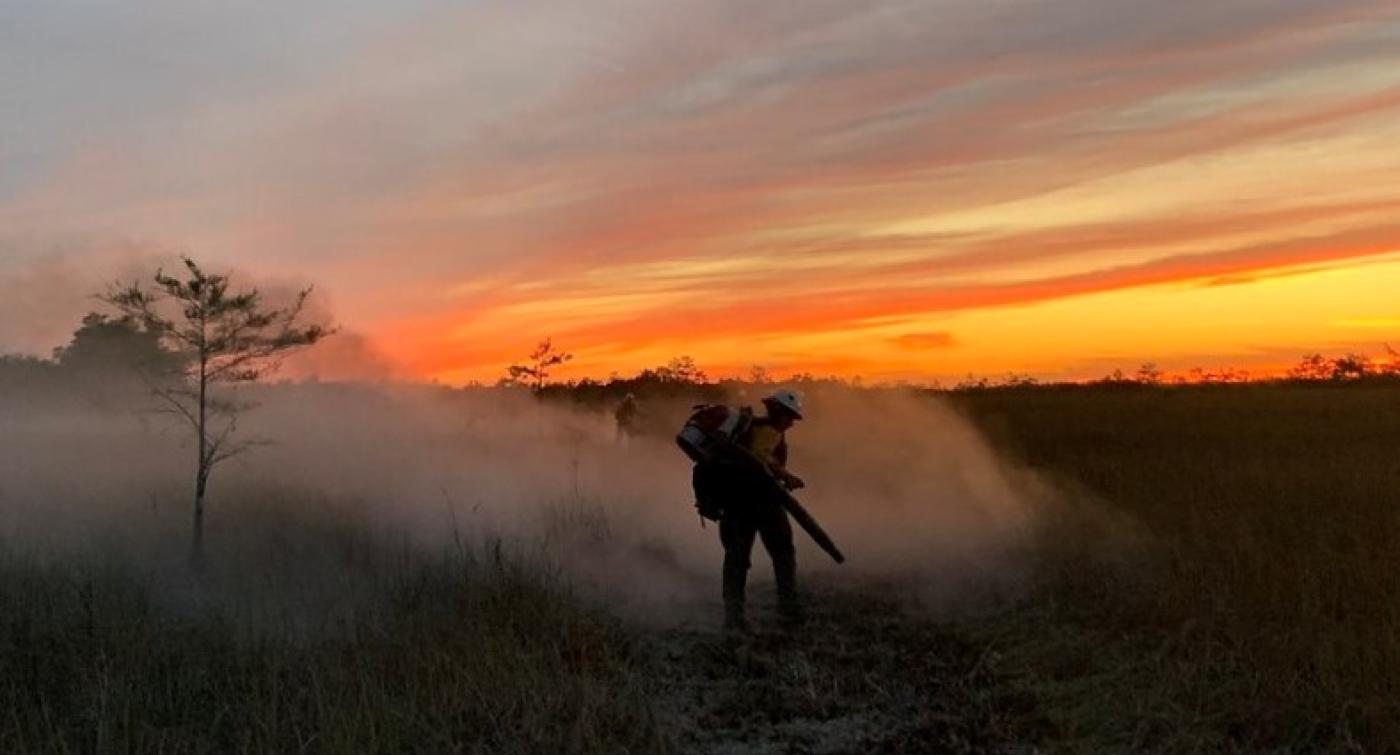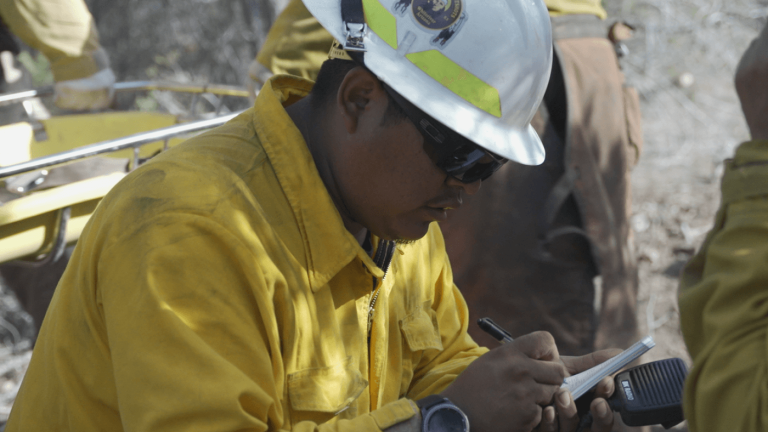Becoming a Qualified Firefighter

The Bureau of Indian Affairs uses the National Wildfire Coordinating Group (NWCG) Standards for Wildland Fire Position Qualifications to determine the specific responsibilities, skills, and certifications required for all individual fire positions.
As you complete training courses, obtain qualifications, and gain work experience in the field, your accomplishments are documented in the Incident Qualifications Certification System (IQCS).
Once you are qualified to work in wildland fire operations, your training officer utilizes the IQCS to issue your Incident Qualification Card, also known as your “Red Card.” This is a pocket-sized document that summarizes your qualifications.
Obtaining a Red Card

Obtaining a Red Card involves a combination of classroom training, a field exercise and, depending on the position, a physical fitness test.
Classroom Training
All first-year firefighters must complete 32 hours of classroom training and online training, which includes:
- Introduction to Incident Command Systems (ICS-100)
- Human Factors in the Wildland Fire Service (L-180)
- Firefighter Training (S-130)
- Introduction to Wildland Fire Behavior (S-190)
- Introduction to the National Incident Management System (IS 700.b)
Field Exercise
After the four-day classroom training, a one-day field exercise allows new firefighters to apply what they learn and exposes them to a controlled scenario for hands-on experience that prepares them for their first wildfire assignment.
Medical screening and approval must be complete prior to any physical fitness testing. The Bureau of Indian Affairs works with the Department of the Interior's Medical Standards Program to provide the medical screening.
Fitness Test
All firefighters and support personnel must pass an annual fitness test. There are three different physical fitness testing levels that are determined based upon their position:
- Arduous: Also known as the “pack test,” you must walk three miles carrying 45 pounds of weight in 45 minutes. This is a requirement for all basic and advanced wildland firefighters.
- Moderate: Also known as the “field test,” you must walk two miles carrying 25 pounds of weight in 30 minutes. This is a requirement for positions such Safety Officer, Prescribed Fire Burn Boss Type 2, and Structure Protection Specialist.
- Light: Also known as the “walk test,” you must walk a mile with no weight in 16 minutes. This is a requirement for positions such as Incident Communications Technician, Prescribed Fire Burn Boss Type 1, and Staging Area Manager.
Annual Fireline Refreshers
To keep your Red Card current, every year you must take at least four hours of Annual Fireline Safety Refresher Training (RT-130), complete the Incident Qualifications and Certification System Responder Update Sheet and submit the sheet to your training officer.
The Wildland Safety Training Annual Refresher (WFSTAR) program is available to firefighters year-round.
Additionally, any annual fitness test required for your position will be performed during the Annual Fireline Refresher.
Developing Qualifications

To develop qualifications, firefighters must take required training produced by the National Wildfire Coordinating Group (NWCG) and complete Position Task Books.
NWCG training courses can be found by utilizing the Wildland Fire Learning Portal (WFLP). The WFLP will also detail how to nominate and enroll for courses, course costs, as well as locations and dates of upcoming courses.
Position Task Books
For every position qualification you earn, there is a Position Task Book (PTB) to teach you the skills necessary to perform that skillset.
Your unit's training officer uses the PTB to document your ability to perform each task associated with the certification you are earning. Tasks may be evaluated through performance, a simulated exercise, or emergency or non-emergency incident/event.
When the PTB is complete and you are nominated for certification, your training officer will certify the PTB and issue the new certification.
For a complete listing of PTBs, visit NWCG Task Books.
Qualifications for Entry-Level Fire Operations Positions
You can find more detailed information on qualifications for all fire positions on the NWCG Standards for Wildland Fire Position Qualifications.
Engine Crews
Firefighters on engine crews start out as Engine Operators (ENOPs) and work their way up to engine bosses (ENGB), who then become engine strike team leaders (STEN). These leaders may oversee two to five engines at a time during wildfire operations.
Hand Crews
First and second year crew members work on earning their FFT1 qualification and ICT5 qualifications. Once accomplished, firefighters begin working on tasks and responsibilities to lead the entire crew. This qualification is called a crew boss (CRWB). Once achieved, they may advance to become a strike team crew leader (STCR), a leader for several crews.
Helitack Crews
Helitack crew members are FFT2s and FFT1s when they start on a helitack crew. They begin earning helitack qualifications as a basic crew member (HECM) and work their way to a helicopter manager (HMGB). After learning to manage a helicopter, HMGBs will certify as helibase managers (HEBM) who will manage the airspace and operations of several helicopters.
Fire Vehicle Driver Courses and Training
Driving is one of the most hazardous tasks firefighters perform. Vehicle-related accidents are often one of the leading causes of firefighter deaths. They are also expensive: medical treatment costs, property and equipment damage and lost productivity.
Not all accidents are avoidable, but training on how to operate and work around vehicles safely can significantly reduce risk.
To learn more, visit the BIA Fire Vehicle Driving Courses and Training webpage.
History of the Firefighter Certification and Qualification Process
The origins of the rigorous fire management position guidelines we see today began in 1994, following the death of 14 wildland firefighters on the South Canyon Fire west of Glenwood Springs, CO.
Following this tragedy, a high level Interagency Management Review Team (IMRT) prepared a report that included a plan for organizational corrective action. Among the recommendations of the IMRT were the following; (1) Establish minimum qualifications for fire managers and agency administrators who are required to make fire management decisions, and (2) Agency Administrators should ensure that personnel holding, or selected for, fire management or agency administrator positions are qualified for the level of wildland fire complexity involved in the position or are able to obtain these qualifications within an acceptable time period.
In 1995 the final report (known as the 1995 Federal Fire Policy) was signed by both Secretaries of Interior and Agriculture and directed wildland fire management agencies to: establish fire management qualifications based on program complexity, and staff existing and future agency administrator and fire management vacancies with individuals who meet these qualifications and who are committed to accomplishing the total fire management program.
In the years that followed, fire management and human resource management experts developed the IFPM standard, including exhaustive lists of job-specific competencies for each of the key fire management positions. In 2004, the IFPM Standard was officially deployed by the Department of the Interior and the Forest Service.
Today, the IFPM Implementation Team provides oversight, guidance and makes recommendations to the National Wildfire Coordinating Group on modifications to the IFPM Standard and the implementation process itself. To learn more about the IFPM Standards and Guidance, please visit the IFPM website.
Additional Information
Related Pages
Contact Us
Boise, ID 83705


